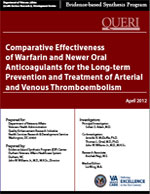
|
Principal Investigator:
Soheir S. Adam, M.D. Evidence-based Synthesis Program (ESP) Center Durham VA Medical Center Department of Veterans Affairs; April 2012 |
Download PDF: Complete Report, Executive Summary, Report, Appendices
Thromboembolic diseases represent a major public health burden and are associated with significant morbidity and mortality. For over 50 years, vitamin K antagonists (VKAs) have been the mainstay of treatment and prophylaxis of thromboembolism. There are many indications for VKA, including primary prevention of systemic embolism in nonvalvular atrial fibrillation (AF) and mechanical prosthetic heart valves. Other indications include secondary prophylaxis following venous thromboembolism (VTE) and preventing stroke in patients with a mural thrombus following myocardial infarction.
In North America, warfarin is the most widely used VKA. In 2004, more than 30 million prescriptions for warfarin were written in the United States. Warfarin significantly reduces the risk for thromboembolic complications in AF, mechanical heart valves, and VTE. However, warfarin therapy has several disadvantages, including its narrow therapeutic window and wide interindividual and intraindividual variability in anticoagulant effect. This variability dictates the need for continuous and regular monitoring, using the international normalized ratio (INR), to maintain patients within the desired therapeutic range. Even with regular monitoring, 30 to 50 percent of INR values fall outside the target range. Furthermore, patients find repeated venipuncture for INR monitoring tedious, and health care providers find it costly.
Over the past decade, several novel oral anticoagulants have emerged. These anticoagulants fall under two drug classes: (1) factor Xa (FXa) inhibitors and (2) direct thrombin inhibitors (DTIs). These drugs characteristically have a predictable anticoagulant effect, eliminating the need for routine monitoring. Moreover they have a faster onset of action, and there is no need to overlap with a parenteral agent when starting thromboprophylaxis�as is the case with warfarin. Warfarin reversal is necessary in some cases of overanticoagulation, which can be achieved using specific products and according to established guidelines. Despite the shorter half-life of new oral anticoagulants compared with warfarin, there are well-founded concerns over the lack of specific antidotes to reverse their anticoagulant effect in a timely fashion in case of bleeding or in preparation for a procedure. These concerns are more pronounced in elderly patients and those with renal impairment. Furthermore, drug acquisition costs are much higher for the newer anticoagulants than for warfarin.
This review was commissioned by the Evidence-based Synthesis Program of the Department of Veterans Affairs (VA) to evaluate newer anticoagulants compared with warfarin. The topic was nominated after a topic refinement process that included a preliminary review of published peerreviewed literature, consultation with internal partners and investigators, and consultation with key stakeholders. We further developed and refined the following key questions (KQs) based on the review of published peer-reviewed literature in consultation with VA and non-VA experts:
The key questions addressed in this report were: